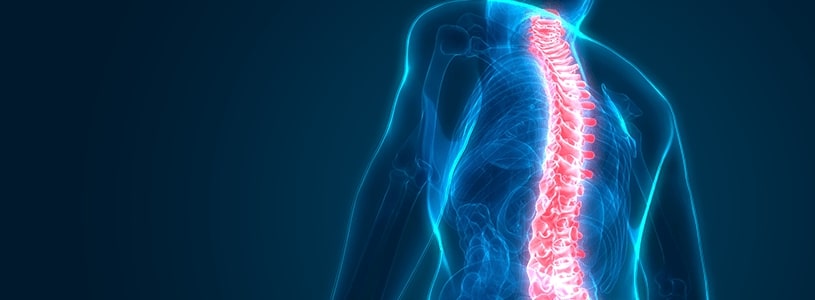
Do I have to get out of bed?
Can’t stand up straight without wincing in pain? Neck so stiff you can barely move it? Is twisting to get in or out of the car an awkward, painful dance?
Neck and back pain can be annoying. It might be a sign of a simple muscle spasm or ligament strain, but persistent neck or back pain can also be caused by a more serious condition, such as arthritis of the facet joints.
Facets
When you hear “joints,” you might think of your knee, elbow, jaw, or hip. But your spine contains many joints as well. The spine is made up of bones called vertebrae that are separated by disks. Each vertebra has two sets of facet joints. These are synovial joints located on either side of the posterior process of the vertebral bodies.
These facet joints link the vertebral bodies together, providing stability, support, and mobility to the spine. These joints allow the spine to perform forward flexion, extension, and twisting motions. Like any other joint, the facet joints have cartilage, which can become worn and thin, preventing normal motion of the spine.
Facet breakdown
Cartilage can break down with injury or age. The cartilage in the facet joints wears away over time, becoming thinner and less supportive. Disks can slip or bone spurs can grow as the bone attempts to adjust to less support from the cartilage. Inflammation can occur as osteoarthritis develops in the facet joints. Degeneration of the facet joints can lead to pain, stiffness, and even pressure on the nerves of the spinal cord.
There are many names for this pattern of breakdown, including:
- Degenerative Facet Joints
- Facet Arthritis
- Facet Disease
- Facet Hypertrophy
- Facet Joint Syndrome
Cervical problems
Vertebrae are usually separated into several groupings. Cervical vertebrae are the neck vertebrae. Thoracic vertebrae make up the mid-back, and lumbar vertebrae make up the lower back. The facet joints of the cervical spine can develop cervical spondylosis, which is arthritis of the neck joints. More than 85 percent of people over age 60 have some degree of this condition, according to the American Academy of Orthopedic Surgeons.
A history of neck injuries increases your risk of developing cervical facet arthritis. Likewise, a job with repetitive neck motions can increase your risk. Genetics and smoking can increase your risk as well. Bone spurs are a common hallmark of this condition.
Pain in the neck
Arthritis and degeneration of the facet joints cause abnormal movement of the vertebral bodies and results in the development of bone spurs. This results in a host of problems that cause painful symptoms. If the cervical facet joints are affected, the following symptoms can occur:
- Neck pain and stiffness, which often worsens with activity
- Grinding sound, as bones scrape against each other with movement of the neck
- Headaches
- Muscle spasms in the neck and shoulders
- Pain that is at its most intense first thing in the morning and then again at the end of the day
- Pain that radiates from the neck into the shoulders and between the shoulder blades
- Stinging pain that travels down the arms
Lower back pain
Low back pain is a very common problem with many potential causes. Degeneration of the facet joints can lead to a spiral of problems that cause serious symptoms such as weakness. As we age and the cartilage between our joints loses water and volume, more pressure is put on each facet joint. In the lumbar spine (the lower back), this can result in arthritis of the lumbar facet joints.
To make up for the lost cartilage, new bone may begin to grow. This causes bone spurs that can pinch nerves. Lumbar facet arthritis can lead to pain and stiffness in the back. If you have this condition, you may find yourself inclined to lean forward often, as this creates more space between the joints and removes pressure on pinched nerves.
Other symptoms of lumbar facet arthritis include:
- Pain after resting or sleeping
- Pain after bending your upper body backward or to one side
- Pain that feels centered in your lower back, but may extend into your buttocks and thighs
- Bone spurs that cause tingling and stinging in your back and limbs
Facet nerve pinch
Nerves in the spinal cord or the nerve roots may become pinched as a result of joint damage. The spinal canal can also become smaller, leaving less room for nerves to pass through the spinal column. Pressure on nerves can result in more profound symptoms, including:
- Numbness and weakness in the arms, hands, and fingers (cervical facet joints)
- Trouble walking, loss of balance, or weakness in the hands or legs (cervical, thoracic, or lumbar joints)
- Burning pain, tingling, or numbness in the buttocks or legs, also called sciatica (lumbar facet joints)
Precision Pain Care and Rehabilitation has two convenient locations in the Richmond Hill – Queens and New Hyde Park – Long Island. Call the Richmond Hill office at (718) 215-1888, or (516) 419-4480 for Long Island office, to arrange an appointment with our Interventional Pain Management Specialist, Dr. Jeffrey Chacko.













